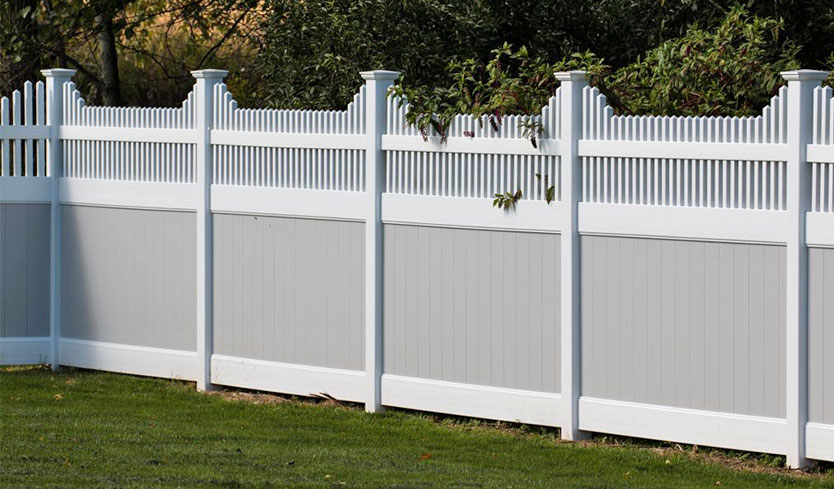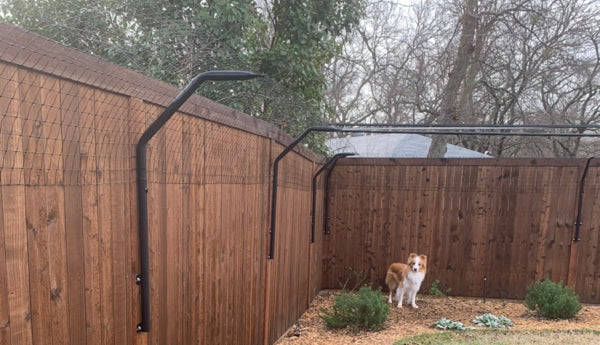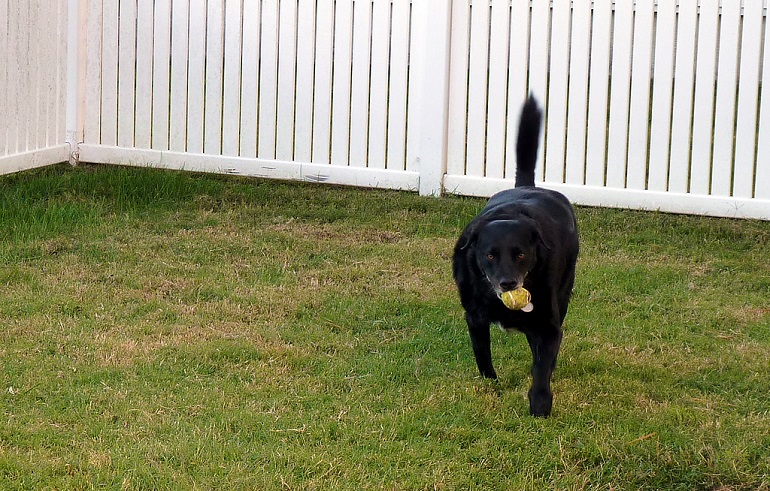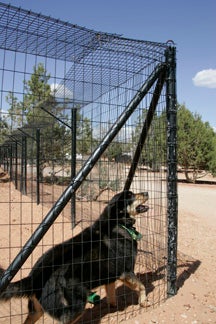Have you ever wondered how to keep your furry friend safe and secure in your backyard? Well, in this article, we’re going to talk all about dog-proof fencing and how it can help you protect your beloved pet. By the end of this article, you’ll have a better understanding of what dog-proof fencing is and why it’s important for dog owners.
Dog-proof fencing is a type of fence specifically designed to keep your dog contained within your property while preventing them from escaping or encountering potential dangers outside. It’s essential for pet owners who want to provide their dogs with a safe and secure outdoor space to play and roam freely. In this article, we’ll discuss the different types of dog-proof fencing, the pros and cons of each option, and how to choose the best one for your furry friend. So, whether you’re a new dog owner or looking to upgrade your current fencing system, stay tuned to learn everything you need to know about dog-proof fencing.
All About Dog-Proof Fencing
When it comes to keeping your furry friend safe and secure, dog-proof fencing is essential. Dogs have a natural instinct to explore and may try to escape from your yard if given the opportunity. To ensure their safety and prevent any unwanted incidents, investing in a dog-proof fence is crucial. There are several types of fencing materials available, each with its own set of advantages and considerations. In this article, we will explore the different types of dog-proof fencing, important considerations, the right materials to choose, installation process, costs, benefits, common problems, maintenance tips, training techniques, alternative solutions, misconceptions, and final conclusions. Let’s dive in!

Types of Dog-Proof Fencing
Wooden Fencing
Wooden fencing is a popular option for dog-proofing your yard. It provides a classic and aesthetically pleasing look while ensuring your dog’s safety. However, it’s important to choose a durable wood, such as cedar or redwood, that can withstand your dog’s natural behaviors. Additionally, wooden fences may require regular maintenance, such as staining or painting, to keep them in good condition.
Chain Link Fencing
Chain link fencing is known for its durability and affordability. It offers excellent visibility, allowing you to keep an eye on your dog while they play in the yard. However, chain link fences may not be suitable for small dogs, as they can easily squeeze through the gaps between the links. Installing privacy slats or panels can help address this concern.
Vinyl Fencing
Vinyl fencing is another popular choice for dog-proofing your yard. It is highly durable, low-maintenance, and resistant to rot and pests. Vinyl fences come in various styles, including privacy, picket, and semi-privacy, allowing you to choose the one that best suits your needs and preferences. However, it’s important to note that vinyl fencing may not be as sturdy as other options and can be damaged by chewing or scratching.
Wire Mesh Fencing
Wire mesh fencing, also known as chicken wire fencing, is an affordable option for dog-proofing your yard. It is made of galvanized steel and has small openings that prevent your dog from squeezing through. However, wire mesh fences may not provide sufficient privacy or aesthetics compared to other materials. They are more suitable for temporary or budget-friendly solutions.
Considerations for Dog-Proof Fencing
Before installing a dog-proof fence, there are several important considerations to keep in mind to ensure you choose the right fencing option for your specific needs.
Height of the Fence
The height of the fence is one of the primary considerations when dog-proofing your yard. You need to select a fence height that prevents your dog from easily jumping over. The appropriate height depends on the breed and size of your dog. For larger breeds, a fence height of at least 6 feet is recommended, while smaller dogs may require a slightly lower fence.
Gaps and Spaces
Dogs are notorious for finding and exploiting any small gaps or spaces in fences. It’s important to choose a fence with minimal gaps between the panels or links, especially if you have a smaller dog. Additionally, regularly inspect your fence for any potential gaps or spaces that need to be filled or repaired to prevent escapes.
Digging Prevention
Some dogs have a natural instinct to dig under fences to escape. To prevent this behavior, you can consider installing a fence with an underground barrier, such as an L-footer, or use concrete or paving stones along the base of the fence. Additionally, providing your dog with supervised playtime, mental stimulation, and designated digging areas can also help discourage digging behaviors.
Climbing Prevention
Certain breeds, such as agile and athletic dogs, may try to climb over fences. To prevent climbing, consider installing a fence with no horizontal bars or with anti-climbing features, such as angled top extensions or a coyote roller system. These measures can help deter your dog from attempting to climb over the fence.

Choosing the Right Material for Dog-Proof Fencing
Selecting the right material for your dog-proof fence is crucial to ensure its durability, maintenance requirements, and overall aesthetics. Consider the following factors when making your decision:
Durability of Materials
Choose a material that can withstand your dog’s behavior and the elements. Some materials, such as vinyl and aluminum, are more durable and resistant to weathering, rotting, or rusting. Others, like wood, may require regular maintenance and may be prone to damage from chewing or scratching.
Maintenance Requirements
Consider the maintenance requirements associated with each type of fencing material. Vinyl and aluminum fences generally require minimal maintenance, such as occasional cleaning. On the other hand, wooden fences may need regular staining or painting to protect them from moisture and keep them looking their best.
Aesthetics and Design
Take into account the overall aesthetics and design of your dog-proof fence. Choose a material and style that matches your personal preferences and complements the architectural style of your home. Discuss with a fencing professional to explore various design options and find the one that suits your taste and budget.
Installing Dog-Proof Fencing
Installing a dog-proof fence requires careful planning and attention to detail. Follow these steps to ensure a successful installation process:
Measuring and Marking
Start by measuring the perimeter of your yard to determine how much fencing material you will need. Mark the location of the fence posts at regular intervals using stakes and string. Ensure accurate placement by working with a professional or following guidelines provided by the fencing manufacturer.
Preparing the Ground
Clear the area where the fence will be installed by removing any obstacles, debris, or vegetation. Level the ground as much as possible to ensure a straight and sturdy fence installation. If necessary, consult a landscaping professional or fence contractor to properly prepare the ground.
Setting the Fence Posts
Dig holes for the fence posts according to the manufacturer’s guidelines or professional recommendations. The depth and diameter of the holes depend on the height and type of fence you are installing. Insert the fence posts into the holes and securely anchor them using concrete or compacted soil.
Attaching the Fence Panels
Once the fence posts are in place, attach the fence panels or mesh to the posts using appropriate hardware, such as brackets or clips. Ensure that the panels are level and properly secured to provide a sturdy and reliable barrier. Follow the manufacturer’s instructions or seek assistance from a fencing professional if needed.

Costs of Dog-Proof Fencing
The cost of dog-proof fencing can vary depending on various factors, such as the materials used, the size of your yard, the labor involved, and any additional features or customization. Consider the following cost considerations:
Material Costs
Different fencing materials have different price ranges. Vinyl and aluminum fences are generally more expensive than wooden or wire mesh fences. Chain link fences occupy the mid-range in terms of cost. Take into account the estimated cost per linear foot for each material and calculate the overall material expenses based on the size of your yard.
Labor Costs
Unless you have the necessary skills and equipment, you will likely need to hire a professional to install your dog-proof fence. Labor costs can vary depending on the complexity of the installation and the local market rates. Obtain quotes from multiple contractors and factor in the labor costs when budgeting for your dog-proof fencing project.
Additional Expenses
When considering the cost of dog-proof fencing, don’t forget to account for additional expenses such as permits, tools, hardware, gates, and any customization or extra features you may require. These costs can add up, so it’s essential to have a clear understanding of your specific needs and budget accordingly.
Long-term Maintenance Costs
While some fencing materials may require minimal maintenance, others may need regular upkeep to ensure their longevity. Consider the long-term maintenance costs associated with each material, such as staining or painting for wooden fences or occasional cleaning for vinyl or aluminum fences. These maintenance expenses should be factored into your overall budget.
Benefits of Dog-Proof Fencing
Dog-proof fencing provides numerous benefits for both you and your furry friend. Let’s explore some of these advantages:
Keeping Dogs Safe and Secure
The primary benefit of dog-proof fencing is the safety and security it provides for your dog. A well-designed and properly installed fence ensures that your dog cannot escape and helps prevent accidents, injuries, or encounters with dangerous wildlife or traffic.
Preventing Escapes and Roaming
Dogs are curious creatures and may try to wander off if not contained within a secure yard. Dog-proof fencing eliminates the risk of escapes and reduces the chances of your dog roaming around unsupervised. This helps maintain good neighborly relations and ensures your dog remains safe within your property.
Protecting Garden and Landscape
If you have a garden or landscaping that you want to protect, dog-proof fencing is essential. Dogs can be mischievous and may dig up plants, trample flowers, or damage your carefully curated landscape. A secure fence acts as a barrier, preventing your dog from accessing sensitive areas and preserving your outdoor space.
Enhancing Privacy
In addition to keeping your dog safe, dog-proof fencing also provides privacy for you and your family. By enclosing your yard with a reliable fence, you can relax and enjoy outdoor activities without worrying about prying eyes. This added privacy can add value to your property and create a peaceful and tranquil environment.

Common Problems with Dog-Proof Fencing
While dog-proof fencing offers numerous benefits, it’s essential to be aware of common problems that may arise. By understanding these challenges, you can take appropriate measures to address them. Here are a few common problems associated with dog-proof fencing:
Dog’s Attempted Escape Strategies
Determined dogs may attempt various escape strategies to overcome the fence barriers. They may dig under the fence, jump over, or try to squeeze through any gaps or spaces. Regularly inspect your fence for potential weaknesses and promptly address any issues to prevent escapes.
Damage from Chewing and Scratching
Some dogs may develop destructive behaviors, such as chewing or scratching the fence. This can cause damage to the materials and compromise the integrity of the fence. Consider using deterrents, such as bitter sprays or anti-chew solutions, to discourage these behaviors and protect your fence.
Intrusions from Wildlife
Dog-proof fencing not only keeps your dog safe but also helps keep wildlife out of your yard. However, some crafty critters may find ways to infiltrate your fenced area. Regularly inspect your fence for any signs of wildlife intrusion and make necessary repairs to prevent potential conflicts or damage.
Maintenance Issues
Failure to provide regular maintenance and inspections can lead to problems with your dog-proof fence. Weathering, rotting, rusting, or other forms of damage can compromise the effectiveness of the fence and pose safety risks for your dog. Stay proactive and conduct regular inspections and maintenance to keep your fence in optimal condition.
Maintenance Tips for Dog-Proof Fencing
To ensure the longevity and effectiveness of your dog-proof fence, follow these maintenance tips:
Regular Inspections and Repairs
Perform regular inspections of your fence to check for any signs of damage or potential weaknesses. Look for loose panels, damaged hardware, rust, or rot. Promptly address any issues by making necessary repairs or seeking professional assistance.
Cleaning and Stain Removal
If you have a wooden or vinyl fence, regular cleaning is essential to maintain its appearance. Use mild soap and water to remove dirt, debris, or any stains that may have accumulated. Avoid using harsh chemicals or abrasive cleaning agents that can damage the fence materials.
Dealing with Rust and Corrosion
If you have a metal fence, such as chain link or aluminum, be aware of rust and corrosion. Regularly inspect the fence for any signs of rust, and promptly treat it using a rust converter or appropriate rust removal solution. Apply a protective coating or paint to prevent future rusting.
Updating and Upgrading
Over time, you may want to update or upgrade your dog-proof fence to enhance its functionality or appearance. Consider adding additional features, such as a gate or access points, to improve convenience. Consult with a fencing professional to explore potential upgrades or modifications specific to your needs.

Training Dogs to Respect the Fence
Install your dog-proof fence is not the only step in keeping your dog safe. It’s important to train your dog to respect the boundaries and understand the purpose of the fence. Here are some training techniques to help ensure your dog remains within the fenced area:
Positive Reinforcement Techniques
Use positive reinforcement techniques, such as treats, praise, and rewards, to reinforce desirable behaviors. When your dog stays within the fenced area, reward them with treats or praise to associate positive experiences with staying within the boundaries.
Boundary Awareness Training
Engage in boundary awareness training to teach your dog where the boundaries of the yard are. Start by walking your dog around the perimeter of the fenced area while using verbal cues like “stay” or “boundary.” Gradually reduce the use of cues and reinforce good behaviors.
Socialization and Exposure
Exposing your dog to various stimuli and socializing them with other dogs and people can help prevent them from feeling the need to escape or explore beyond the fence. Organize playdates or enroll in obedience classes to provide your dog with adequate socialization opportunities.
Tips for Dog-Proofing Existing Fences
If you already have an existing fence and want to make it dog-proof, here are some tips to consider:
Adding Extensions or Barriers
If your existing fence is not tall enough, consider adding height extensions to prevent your dog from jumping or climbing over. Use mesh or additional fencing materials to create a barrier at the top of the fence that prevents escapes.
Filling Gaps and Holes
Inspect your existing fence for any gaps, holes, or damaged areas where your dog might attempt to escape. Fill these gaps using additional fencing materials, such as wire mesh or wood, to reinforce the integrity of the fence.
Reinforcing Weak Points
Identify any weak points in your existing fence, such as loose panels, damaged hardware, or rotting posts. Reinforce these weak points by making necessary repairs or consulting with a fencing professional to ensure the fence is secure.
Using Deterrents
If your dog displays destructive behaviors, consider using deterrents to discourage chewing or scratching. Apply bitter sprays, anti-chew solutions, or deterrent devices designed specifically for dogs to protect your fence from damage.
Dog-Proof Fencing Regulations and Permits
Before installing a dog-proof fence, it’s important to familiarize yourself with any regulations or permits that may be required. Pay attention to the following considerations:
Local Zoning Regulations
Check your local zoning regulations to determine specific requirements for fence height, materials, setback distances, or any other restrictions. Non-compliance with local zoning regulations can result in fines or forced removal of the fence.
Homeowner Association Rules
If you live in a neighborhood with a homeowner association (HOA), review the rules and regulations regarding fence installation. HOAs may have specific guidelines regarding fence height, materials, and even color. Seek approval from the HOA before proceeding with any fence installation.
Permitting and Application Process
Some municipalities may require permits for fence installation, especially for taller or permanent fences. Contact your local building department to inquire about any necessary permits or applications. Ensure that you have obtained all the required approvals before starting the installation.
Neighbor Agreements
If your dog-proof fence will border a neighbor’s property, it’s important to communicate and obtain their agreement, especially if the fence will be shared or has an impact on their view. Discuss the proposed fence installation with your neighbor and address any concerns or potential boundary disputes.
Alternatives to Traditional Dog-Proof Fencing
While traditional dog-proof fencing is effective for many homeowners, there are alternative solutions to consider based on your specific situation and requirements. Explore these alternatives:
Electric Dog Fences
Electric dog fences, also known as underground or invisible fences, use wireless technology to create invisible boundaries for your dog. These fences consist of a buried wire and a receiver collar that emits a harmless static correction if the dog crosses the boundary. Electric dog fences are generally less expensive than traditional fences but do require training and may not be suitable for all dogs.
Invisible Boundary Systems
Similar to electric dog fences, invisible boundary systems use wireless technology to create invisible boundaries. Instead of a buried wire, these systems rely on GPS tracking or radio signals to define the boundaries. Invisible boundary systems can be portable and are suitable for homeowners who may need to set boundaries in different locations.
Portable Fencing Solutions
If you require temporary or portable fencing solutions, consider using portable dog fences or playpens. These fences are often made of lightweight materials, such as plastic or mesh, and can be easily assembled and disassembled as needed. Portable fencing solutions are ideal for camping, traveling, or providing temporary enclosures for your dog.
Tethering and Tie-Out Options
Tethering or tie-out options involve securing your dog to a fixed point using a leash or cable. This method allows your dog to have limited freedom within a designated area while ensuring they remain secure. However, tethering should be used only under supervision and should not be a long-term solution for dog-proofing. Ensure that your dog has access to water, shelter, and is not left unattended for extended periods.
Common Misconceptions About Dog-Proof Fencing
There are several common misconceptions and myths surrounding dog-proof fencing. Let’s debunk some of these misconceptions:
Fence Height and Dog Breeds
It is a common misconception that all dogs can be contained within a certain fence height. The appropriate fence height depends on the breed and size of your dog. Some breeds are more agile and can easily jump over fences, regardless of the height. Consider your dog’s specific traits and consult with professionals when determining the appropriate fence height.
Effectiveness of Different Materials
Each type of fencing material has its own advantages and considerations. There is no one-size-fits-all solution when it comes to dog-proof fencing materials. The effectiveness of a dog-proof fence depends on various factors, such as the dog’s behavior, training, and the overall condition of the fence.
Impact on Property Value
Installing a dog-proof fence can have a positive impact on your property value. It enhances safety, security, and privacy, which are desirable features for potential buyers. However, it’s important to choose a fence with a design and style that complements your property, as a poorly designed or damaged fence may have a negative impact on property value.
Limited Options for Rental Properties
While homeowners have more flexibility in choosing dog-proof fencing options, renting a property may present limitations. However, there are still solutions available, such as portable or temporary dog fences, that can provide a safe and secure environment for your dog without making permanent modifications to the property. Discuss your options with the property owner or management to find a mutually beneficial solution.
Conclusion
Dog-proof fencing is an essential investment for any dog owner. It ensures the safety and security of your furry friend while providing peace of mind knowing that they’re contained within a secure environment. In this article, we discussed the different types of dog-proof fencing, important considerations, choosing the right material, installation process, costs, benefits, common problems, maintenance tips, training techniques, alternative solutions, misconceptions, and final conclusions. By understanding the various aspects and taking into account your specific needs, you can make an informed decision and create a safe and enjoyable space for both you and your dog.
Remember to regularly inspect and maintain your dog-proof fence to ensure its longevity and effectiveness. By providing a secure and well-maintained environment, you can ensure the happiness and well-being of your furry friend for years to come.